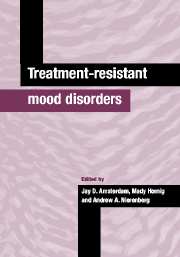Book contents
- Frontmatter
- Contents
- List of contributors
- Preface
- Part I The clinical problem
- Part II Biological basis
- Part III Treatment approaches
- Part IV Special patient populations
- 14 Chronic and refractory mood disorders in childhood and adolescence
- 15 Treatment-resistant depression in the elderly
- 16 Management of treatment-resistant depression during pregnancy and the postpartum period
- 17 Preliminary algorithms for treatment-resistant bipolar depression
- 18 Medical disorders and treatment-resistant depression
- 19 Psychiatric comorbidity in treatment-resistant depression
- 20 Suicide in treatment-refractory depression
- Part V Economic and ethical issues
- Index
- Plate Section
20 - Suicide in treatment-refractory depression
from Part IV - Special patient populations
Published online by Cambridge University Press: 25 March 2010
- Frontmatter
- Contents
- List of contributors
- Preface
- Part I The clinical problem
- Part II Biological basis
- Part III Treatment approaches
- Part IV Special patient populations
- 14 Chronic and refractory mood disorders in childhood and adolescence
- 15 Treatment-resistant depression in the elderly
- 16 Management of treatment-resistant depression during pregnancy and the postpartum period
- 17 Preliminary algorithms for treatment-resistant bipolar depression
- 18 Medical disorders and treatment-resistant depression
- 19 Psychiatric comorbidity in treatment-resistant depression
- 20 Suicide in treatment-refractory depression
- Part V Economic and ethical issues
- Index
- Plate Section
Summary
Introduction
Depression in certain types of individuals carry an increased risk of suicide, and the longer they go unsuccessfully treated, the greater the risk becomes. Treatment-resistant depression (trd) which for this discussion signifies a form of depression that does not readily fully respond to treatment, leaves its victim in continual suffering and vulnerable to a full relapse, with associated increased suicide risk. Treatment-refractory depression (TRD) is used to define a type of depression that for all intents and purposes shows no response to a series of adequately delivered treatments, leaving its victim to suffer the severe symptoms and disability of a full episode, as well as both depression related and realistic hopelessness. In the context of untreated high risk factors and increasing despair, as treatment after treatment fails to help, it is no mystery that either form accentuates the risk of suicide inherent in a high risk individual.
What forms of trd/TRD carry a high risk of suicide? One of the most common forms of trd/TRD is that with comorbid severe psychic anxiety (Fawcett et al., 1990). A number of studies have shown that comorbid anxiety symptoms such as panic attacks, phobias, and obsessional symptoms have poor treatment outcomes compared to uncomplicated depression, both in terms of requiring more treatment courses, and more use of multiple medications to attain response, with partial response (trd) as a common outcome, and a related higher rate of relapse (Clayton et al., 1991).
Keywords
- Type
- Chapter
- Information
- Treatment-Resistant Mood Disorders , pp. 479 - 488Publisher: Cambridge University PressPrint publication year: 2001
- 1
- Cited by



